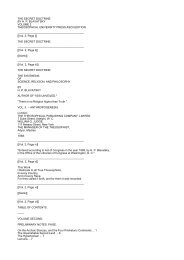Create successful ePaper yourself
Turn your PDF publications into a flip-book with our unique Google optimized e-Paper software.
The Gods Of The <strong>Book</strong> Of The <strong>Dead</strong>.<br />
daily in th temple <strong>of</strong> Amen-Ra at Thebes to deliver <strong>the</strong> Sun-god from <strong>the</strong> assault <strong>of</strong> this fiend and on each<br />
occasion it was accompanied by a ceremony in which a waxen figure <strong>of</strong> Apep was burnt in <strong>the</strong> fire; as<br />
<strong>the</strong> wax melted, so <strong>the</strong> power <strong>of</strong> Apep was destroyed. Ano<strong>the</strong>r name <strong>of</strong> Apep was Nak, who was pierced<br />
by <strong>the</strong> lance <strong>of</strong> th eye <strong>of</strong> Horus and made to vomit what he had swallowed.[9]<br />
The Devourer <strong>of</strong> <strong>the</strong> <strong>Dead</strong><br />
The judgment scene in <strong>the</strong> Theban edition <strong>of</strong> <strong>the</strong> <strong>Book</strong> <strong>of</strong> <strong>the</strong> <strong>Dead</strong> reveal <strong>the</strong> belief in <strong>the</strong> existence <strong>of</strong> a<br />
tri-formed monster, part crocodile, part lion, and<br />
[1. Maspero, Recueil de Travaux, t. iii., p. 220.<br />
2. Goodwin, Aeg. Zeitschrift, 1866, p. 54; see also Lepsius, Aelteste Texte, Bl. 35, l. 1 ff.<br />
3. Naville, Todtenbuch, Bd. I., Bl. 44.<br />
4. Ibid., Bd. I., Bl. 46.<br />
5. I.e., chapp. 32, 34, 35, 36, 37, 38, etc.<br />
6. For <strong>the</strong> text see Naville, Todtenbuch, Bd. I., Bl. 53; and Lepsius, Todtenbuch, Bl. 18.<br />
7. See Lanzone, Dizionario, p. 121.<br />
8. The service for <strong>the</strong> Overthrowing <strong>of</strong> Apepi is printed in Archæologia, vol. lii., pp. 393-608.<br />
9. ###. Grébaut, Hymne, p. 10.]<br />
{p. cxxx}<br />
part hippopotamus, whom <strong>the</strong> Egyptians called Am-mit, i.e., "<strong>the</strong> eater <strong>of</strong> <strong>the</strong> <strong>Dead</strong>," and who lived in<br />
Amenta; her place is by <strong>the</strong> side <strong>of</strong> <strong>the</strong> scales wherein <strong>the</strong> heart is weighed, and it is clear that such hearts<br />
as failed to balance <strong>the</strong> fea<strong>the</strong>r <strong>of</strong> Maat were devoured by her. In one papyrus she is depicted crouching<br />
by <strong>the</strong> side <strong>of</strong> a lake.[1] O<strong>the</strong>r types <strong>of</strong> evil were <strong>the</strong> insect Apshai, [2]confounded in later times with <strong>the</strong><br />
tortoise[3], which dies as Ra lives;[4] <strong>the</strong> crocodile Sebak, who afterwards became identified with Ra;<br />
<strong>the</strong> hippopotamus, <strong>the</strong> ass, etc.<br />
The devils <strong>of</strong> <strong>the</strong> underworld.<br />
The pyramid texts afford scanty information about <strong>the</strong> fiends and devils with which <strong>the</strong> later Egyptians<br />
peopled certain parts <strong>of</strong> <strong>the</strong> Tuat, wherein <strong>the</strong> night sun pursued his course, and where <strong>the</strong> souls <strong>of</strong> <strong>the</strong><br />
dead dwelt; for this we must turn to <strong>the</strong> composition entitled <strong>the</strong> " <strong>Book</strong> <strong>of</strong> what is in <strong>the</strong> Tuat," several<br />
copies <strong>of</strong> which have come down to us inscribed upon tombs, c<strong>of</strong>fins, and papyri <strong>of</strong> <strong>the</strong> XVIIIth and<br />
following dynasties. The Tuat was divided into twelve parts, corresponding to <strong>the</strong> twelve hours <strong>of</strong> <strong>the</strong><br />
night; and this <strong>Book</strong> pr<strong>of</strong>essed to afford to <strong>the</strong> deceased <strong>the</strong> means whereby he might pass through <strong>the</strong>m<br />
successfully. In one <strong>of</strong> <strong>the</strong>se divisions, which was under <strong>the</strong> rule <strong>of</strong> <strong>the</strong> god Seker, <strong>the</strong> entrance was<br />
guarded by a serpent on four legs with a human head, and within were a serpent with three heads,<br />
scorpions,[5] vipers, and winged monsters <strong>of</strong> terrifying aspect; a vast desert place was <strong>the</strong>ir abode, and<br />
seemingly <strong>the</strong> darkness was so thick <strong>the</strong>re that it might be felt. In o<strong>the</strong>r divisions we find serpents spitting<br />
fire, lions, crocodile-headed gods, a serpent that devours <strong>the</strong> dead, a huge crocodile, and many o<strong>the</strong>r<br />
reptiles <strong>of</strong> divers shapes and forms.<br />
From <strong>the</strong> descriptions which accompany <strong>the</strong> scenes, it is evident that <strong>the</strong> Tuat was regarded by <strong>the</strong><br />
http://www.sacred-texts.com/egy/ebod/ebod09.htm (17 <strong>of</strong> 19) [8/10/2001 11:23:59 AM]

















